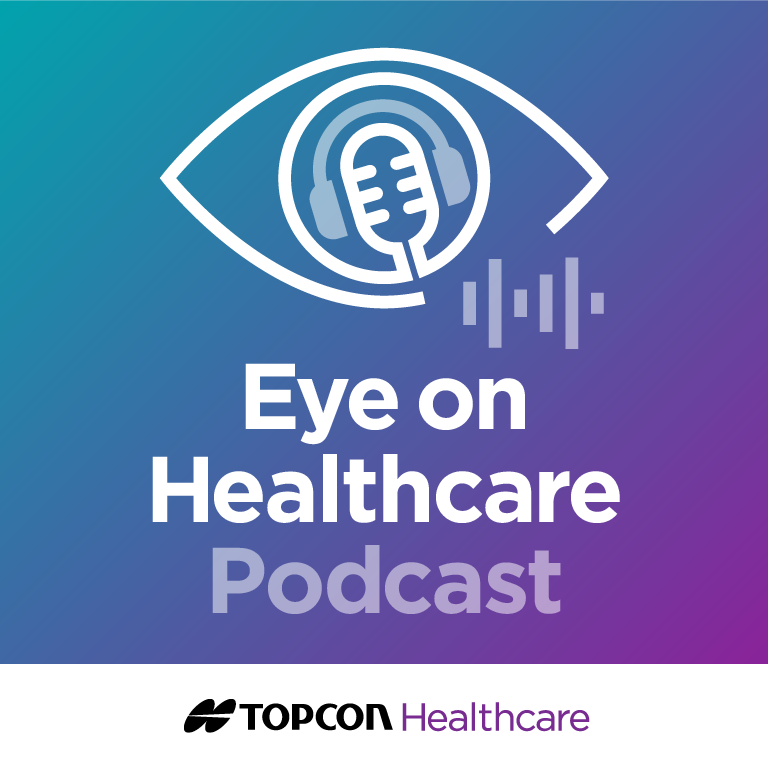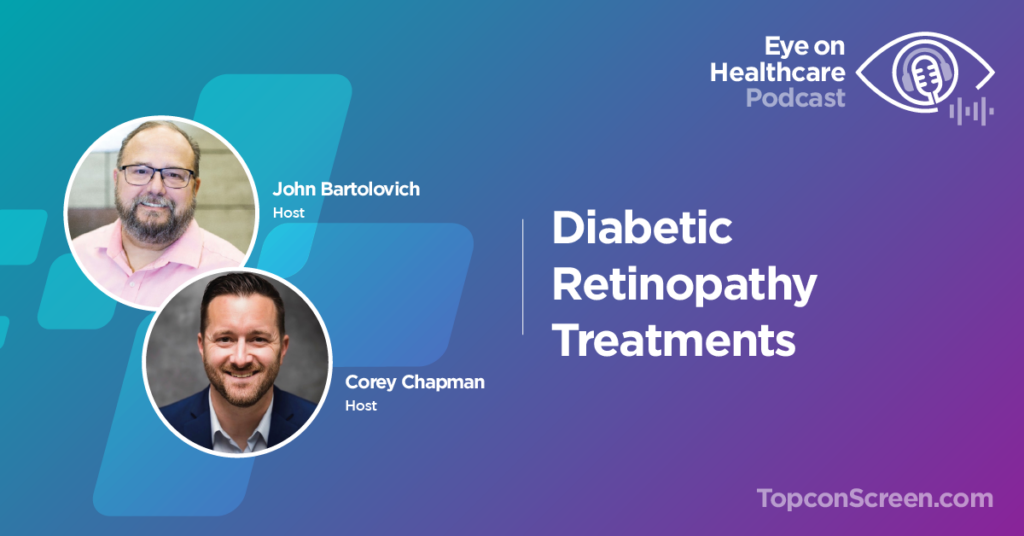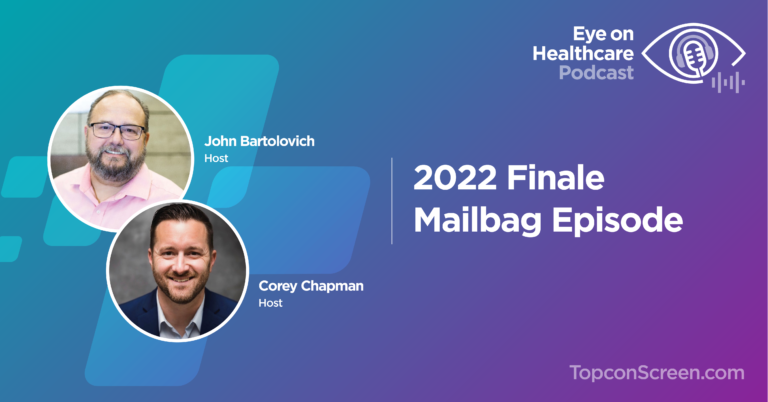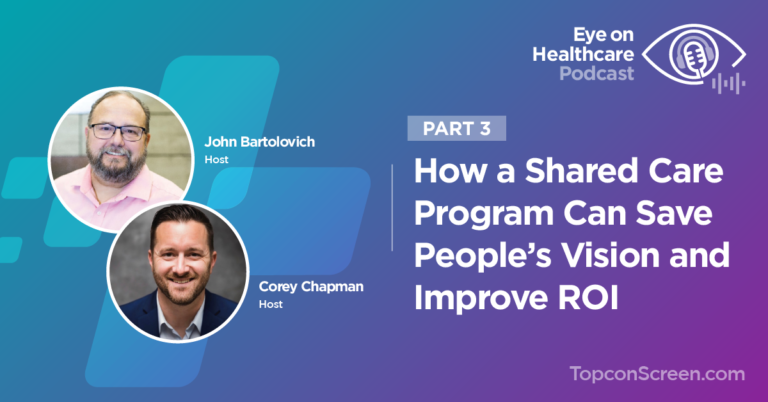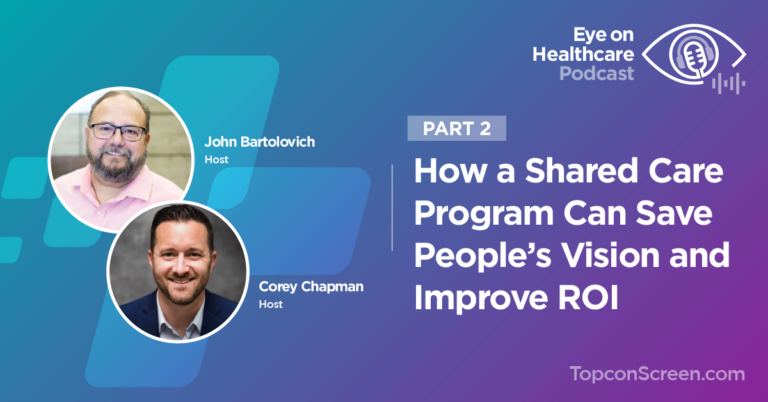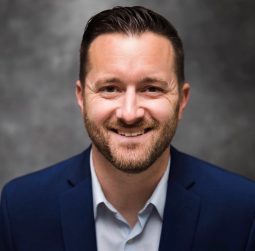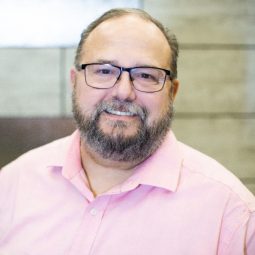Episode Transcript
Corey: Welcome back to another episode of the Eye on Healthcare podcast. I’m your host Corey chapman, always excited to have my co-host with me, another week another podcast with John Bartolovich. John is the healthcare economics and reimbursement manager for Topcon Screen. Welcome back John
John: great to be back, Corey.
Corey: great to have you. So we had a very exciting episode on FQHC’s last time and it brought a lot of DMS about it, a lot of questions around it, and there is a hunger to learn more about this especially if you’re in the healthcare space and you’re not overly familiar with that, so, even though we have a particular topic we’re going to talk about, I think they blend in together on this episode and I’d love for you to walk us down the path to really understand social determinants of health. I know it’s a complex subject matter but please be our Sherpa, our guide down this road, can you tell those who are maybe familiar with these buzzwords / buzz phrase right now, what it encompasses and we can kind of talk through it
John: absolutely, the easiest definition would be to say that these are the conditions in the places where people live, work, learn, and play that effect a wide range of health risks in the outcomes associated with those risks.
Corey: OK so if I live in upstate New York and a rural area and you live in Ohio in a larger city even if we’re the same age now, maybe the same background same diet, there are there could be different things that are affecting us on how we, approach our health style, you know that that sort of thing?
John: absolutely I guess one of the one thing to keep in mind is there’s really no consensus as to what the social determinants of health are. For instance, county health rankings list 3 categories for social determinants of health and Kaiser Family Foundation uses six for the sake of what we’re going to talk about today, I think Healthy People 2030 has probably the best framework and they break it down into five categories
Corey: OK so before we get into, can you tell me the five categories and then we’ll hit him off one at a time?
John: absolutely, first one would be economic stability, the second would be education access and quality, third would be healthcare access and quality, the 4th would be the neighborhood and built environment and then the last one would be social and community context.
Corey: now they all sound exciting and interesting but one caught my attention, so I want to start with neighborhood and built environment. Tell me more about that
John: when you’re talking about neighborhood and built environment probably the easiest way to think of it is think about the neighborhood, is it in a high pollution area? is there lead pipes? you know Flint MI comes to mind, do the folks in the neighborhood have access to not only quality food but healthy food? foods that will support a healthy eating pattern, what’s the quality of the housing? do they have access to transportation? so those are the things that when you’re looking at that just off the top of my mind couple of things that would impact a diabetic are going to be the access to quality foods and foods that will support a healthy eating pattern and then transportation, how many times, in this could be in a rural or in an inner city, how many times we have an issue where a patient can’t get to a doctor’s appointment?
Corey: yeah right, I mean I we hear about it all the time. I know with diabetic retinopathy screening it becomes an issue where if it’s not done at point of care, then yes, it’s all I have to find a ride or I have to check the bus schedule or anything like that so yeah that makes a lot of sense
John: exactly, I mean I’ve been talking with a couple of providers in the West Virginia area and the issue they’re dealing with is with point of care screening, and they want to implement it, is because their patients can’t travel the 60 or 80 miles to go see a specialist to get that eye exam done
Corey: sure right, they’re not in a major metropolitan area, it may be like you said, an hour or two away to go see a specialty physician, so yeah that makes a lot of sense. OK tell me a little bit about healthcare access and quality
John: this really ties back into Corey the conversation we had last week about, a lot of people don’t realize this, but when it comes to healthcare one in ten Americans are uninsured and people without insurance are less likely to have a primary care physician so, you know, in an inner city it’s easy easier maybe, I don’t know, they might have an FQHC in the neighborhood. I know there are a lot of rural FQHC’s that are out there as well but the whole key is they need to have access to the basic disease prevention and that’s very difficult if they don’t have a primary care physician. Many diabetics for instance they rely on their primary care physician more than they see a specialist for a variety of reasons and again it goes back to, is it the transportation issue? is it timing? is it financial reasons? we don’t know but we do know that many people don’t have access to just even basic disease prevention through a primary care physician
Corey: OK yeah that makes sense as well that, you know again, going back to the whole specialty piece where you know it’s almost better to go to an endocrinologist or an ophthalmologist because that is, specific point of care, you know, treatment having to have just general help might not be the best access
John: right, I mean, if I think about it, if a patient is having trouble locating or having a primary care physician is going to be that much harder for them to get blood work done, to maintain good blood pressure control, to maintain good glucose control and to even get neuropathy tests, the basic foot test or even an eye exam to check for diabetic retinopathy
Corey: OK yeah that makes sense. So, what about education access and quality?
John: typically comes down to and it ties in there, they’re all really interconnected, I guess it would be one thing to talk about but you know Healthy People 2030 highlights that children that come from low income families or children with disabilities and children that are routinely discriminated against or bullied, are likely to struggle in math and reading so when you have that as a basic pretext, they’re going to be less likely to go to college, they’re going to be less likely to find the type of jobs that are high paying, and then that just goes back into that circle with, you know, they’re going to have limited access to healthcare or quality healthcare, they’re going to have transportation issues, so all of these determinants are interconnected.
Corey: They are so intricate too. I mean, you just you mentioned something, at an early age of bullying and it just dominoes into something that affects them so far down the road… unbelievable… so fascinating stuff. OK so two more to cover and then we can get a recap on everything but tell me about the economic stability
John: this is probably it is an underlying, well underlying determinant for all of these and a lot of that goes to, you know, one in ten Americans live in poverty, many people have trouble finding and keeping a job that provides for a living wage, you couple that with people with disabilities or injuries like arthritis or conditions like arthritis, that could limit the way in their ability to perform certain , types of work uh because of the low incomes they may not have help access to fresh vegetables, fresh meats, so we’re buying a lot of packaged foods and pre processed foods, so that you know they’re living in a food desert, makes it hard for them to get quality food and that’s just going to exacerbate any health issues and then again it could be limited access to childcare you know. I often tell the story when I’m talking with our clients about being at a Medicare conference and one of the presenters talking about a physician saying that a particular patient was non-compliant, they never showed up for their specialty appointments, and the presenter said, you know I happen to know this this individual and it wasn’t that they didn’t want to go to the doctor’s appointments or to the specialist appointments. It was this individual daughter worked at Walmart. It was the only job she could find, and she had two kids that had to be taken care of and if grandma didn’t watch the two kids, mom couldn’t go to work, and if mom couldn’t go to work, there was no income coming into the house. So, you know, that economic stability is going to affect all kinds of things, not only from the actual income coming into the house, but childcare, food things, things that a lot of us take for granted
Corey: OK and then the last one, social and community context, tell us about it
John: this one ties back into the if 2 people have people they can rely on for childcare. If there are issues in the family, abuse, is there somebody that they can talk to? is there discrimination going on? because of a disability or things, something like that, that’s what we’re really talking about when it comes to social and community context, really a cohesion, I guess really getting back to the old adage of it takes a village and for many people that village just isn’t out there
Corey: OK so this has been enlightening. So, let’s talk a little bit about how and then we can wrap here but let’s talk a little bit about how this all effects just primary care, just patients in general. I know there’s a ton of things to talk about, there’s 100 Dominos, or different combinations that could be affected here. When a primary care office, we will use patient a, or use me as patient a, is there a way that all of these different things are compiled? is that something within a population health that within a health system that they can look at and then they work towards, not correcting, but filling in those type of gaps where there are some, how are we using this information today?
John: you’re starting to see a drive, a push towards healthcare starting to collect this type of data and look at this type of data to help bring, the new buzzword is, healthcare equity to all people and you know the difference is there’s some people out there that can afford the best treatment in the world then there’s others that can barely afford treatment. Organizations like CMSR are really pushing for, what can we do to make sure that we’re providing quality healthcare to every patient not just those that can afford it? so short answer, yes, we’re starting to see practices via their electronic records, via their outreach, starting to look at and address the social determinants of health when and where they can
Corey: OK so I imagine if I look at the scale of how much funding is available, I would think payers and large health systems probably have put some funding into that, where do FQHC’s fall into that? are they starting to go this route as well? because it feels like or, just the way you’re explaining this to me, they would be the most positively affected by understanding these social determinants of health. So, are we starting to see that across the board or is it more with the bigger systems that are tied to certain measures? is it trickled all the way down to those federally qualified health systems?
John: actually, I think it’s a push up from the federally qualified systems. There’s some data out there that shows that patients getting treatment at an FQHC have some of the better outcomes that you’re going to find out there when it comes to such things as blood pressure control, their blood glucose HBA 1C measures, and that is because as FQHC in the name, it’s a federally qualified Health Center but they are charged with meaning quality care measures, and have been since their inception
Corey: OK John, this has been fantastic information. Again, social determinants of health, I’ve seen it quite a bit, articles about it. It’s on LinkedIn, I don’t want to use buzz words because obviously buzz kind of feels like it’s going to come and go and this is absolutely going to be here long term, but we’re starting to hear this phrase a lot more and it’s going to be here for a long time, so, my last question to you is: with all this fantastic information that you’ve just provided us, how does Topcon work into this? obviously your work around health economics, how does Topcon fit into this?
John: Topcon fits into this in a in a very unique way, that is, for the diabetic patient out there, getting this diabetic eye exam, which is a necessity and it’s going to help to keep healthcare utilization low when these patients get this done, it doesn’t have to cost an arm and a leg. The pun is intended and the reason I say that is Topcon can help. If you’re a primary care practice contact your Topcon rep, we can talk to you about reimbursement support, we can talk to you about minimum commitment contracts, we can talk to you about how you could put a camera in your office today that is not going to break the bank but is going to allow you to provide gap closing tests to your patient. If you’re an FQHC contact Topcon. We’ve got people on board that can help you find grant funding sources and we can help lay some of that groundwork for you. Topcon wants to be your partner in helping prevent blindness for your diabetic patients and we want to make sure that the barriers to the patient are eliminated but also that the barriers to the practice for providing this level of quality care are also eliminated
Corey: I couldn’t say it better myself John, thank you. So, for John Bartolovich, this is Corey Chapman, it’s been another episode of the eye on healthcare podcast, thanks so much!

